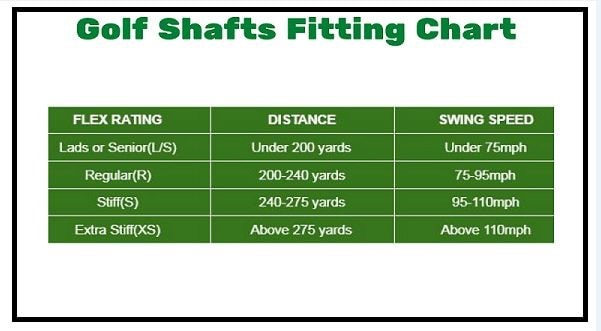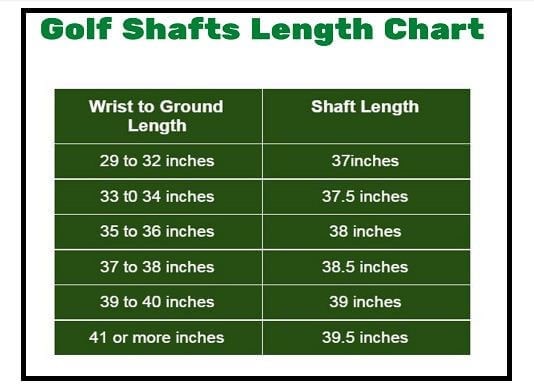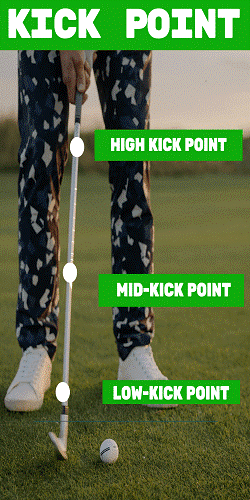Table of Contents
So you are done with your old shaft. Now things are getting serious, and you want to upgrade your clubs. Because you really want to take your golfing skills to the next level. BRAVO!
No doubt the shafts have a significant impact on the overall distance, spin, and trajectory of a shot. But selecting the right shaft is not a piece of cake. After all, there are so many kinds of shafts with so many different specs that you find yourself completely bewildered to decide which one to choose from the plethora of shafts.
Finally, this forces you to ask Google, “Which golf shaft is the best for me?” Unfortunately, the answer is not simple. Why?
Think…
Onward.
Look, updating to a new and better golf shaft has no issues at all but the process of selecting the right shaft has.
And I’m 100% sure that it’ll definitely blow your head away if you are naive about golf. Because it is so overwhelming to decide upon which factor to look at and what to ignore.
Do you know why? This is because the performance of a shaft is affected by so many factors that it becomes extremely difficult to find the right balance.
And if you are not experienced you might go home with a wrong shaft in your hand. Also, after playing with the shaft for some days you may feel like it’s better to break it intentionally since it brought no good to you nor to your game. On the other hand, it took away your hard-earned money.
However, if you read this article( fully) from the top to bottom. I guarantee you that this comprehensive guide will give you all the information you need to go to the golf shop and pick the right shaft ALONE.
So let’s jump on to our guide. Be with me!
How to Pick the Right Shaft for You
While selecting the right shaft you need to consider a lot of factors that can affect the performance. Though not all the factors are equally important- Some dominate others.
Like flex, shaft length, weight, and material are extremely important while others are less important ones are the price, kick point, and distance control. Anyway, stay focused, as we are going to break down each of these factors independently. Let’s get started…
#1. Golf Shaft Type: Steel vs Graphite
Golf clubs come in two basic kinds of shafts— steel and graphite.
The best practice is to choose the same material your club originally came with. Here I ain’t saying that you can’t change the shaft as you desire. Of course, you can change it anytime you want. So, it’s better to know the difference between the two before you actually choose one.
I. Steel Shafts
They are heavier and more durable shafts than iron shafts. They have low torque and do not scratch easily due to the absence of a painted surface. The downside is steel makes these shafts heavier and they are expensive.
Steel shafts are difficult to swing due to their heavyweight but once you get them right they provide you better controlled and long-distance shots.
II. Graphite shafts
They are lighter, have more torque ratings, and come in a wide range. They are also affordable. Their downside is they are not as durable as steel shafts, have poor control.
Graphite shafts are better for beginners as they have a slow swing and less power in their shots. Since these shafts are light they are easier to swing, provide more spin and higher trajectory than steel shafts.
#2. Which Golf Shaft Flex is Right for me?
Why is golf club shaft flex so important? The answer is shaft flex affects the distance, speed, and trajectory of your shot.
According to a study done by Jay Worobets and Darren Stefanyshyn, it was found that the stiffness of the shaft can affect the ball launch condition due to the alteration in the clubhead speed and/or loft angle.
In simple words, flex is understood as the capability of the shaft to bend during the swing. The shaft with softer flex bends more than the stiffer flex and vice versa.
Now the question is which flex to choose? The rule of thumb is- “ the stiffer shaft keeps the ball low, with less spin and cover more distance while the softer shafts, on the other hand, give you more height, more spin but cover less distance.”
So as a beginner, you would have less powerful swings naturally. Hence, it’s best to go with a shaft with greater flexibility to propel the ball more. On the other hand, if you have a powerful swing speed, then I advise you to go with stiffer shafts with less flex.
Shafts come in a range of flex ratings such as:
- Extra stiff (XS)
- Stiff (S)
- Regular (R)
- Senior (S)
- Amateur (A)
- Ladies (L)
Comment: Unfortunately, there are no industry standards that exist for the flex and these ratings vary from brand to brand. This means that shaft flex for one manufacturer ‘S’ might fall in the ‘F’ range of the other.
So, before selecting the shaft rating you need to consider your swing speed. For your ease, I have designed a table that will help you select the right rating based on the swing speed and distance you get in your shots:
Golf Shafts Flex Comparison Chart: Golf Shaft Flex Calculator
#3. Which Shaft Length is Right for me?
Should you really care about the shaft length? Well, yes! Shaft length plays a significant role in the consistency of the shots. According to a study, improvements can be brought about in the shot performance by adjusting the driver length. This is because of the increase in the hip/shoulder differential angle at the top of the backswing and the increase in the predicted muscle force.
To put it simply, longer shafts tend to provide less consistent strike and the impact location comes closer to the heel. On the contrary, shorter shafts provide a more consistent swing and impact the balloon somewhere near the toe.
How to Measure the Length of a Club Shaft
To measure the shaft length, first, stand straight and ask someone to measure the length from the first crease of your wrist to the ground and NOTE THAT LENGTH. Now consider the following chart:
Golf Shaft Length Chart: Shaft length Calculator
#4. Weight
The weight of the shaft also has affected the distance, control, spin, and trajectory. Heavier shafts help you to have better control shots, keep the trajectory and spin low and drive the ball further.
Lighter shafts on the other hand do just the opposite. So, if you are a beginner go with a lighter shaft till you develop a serious swing speed and power in your shots. And once you get that, switch over to a heavier shaft.
#5. Torque
When you hit a ball there is a twisting force act on the shaft which forces it to rotate. This force is known as torque. Now you may wonder, how does this affect the selection of the shaft?
Listen up! Torque is the factor that determines the feel of the shaft. The shaft with low torque tends to feel stiffer than the shaft with high torque even if both the shafts have the same flex ratings. It also affects the swing speed rating.
So now it’s up to you, what do you want…a stiffer feel or softer feel…when you hit the ball?
#6. Kick Point
Kick point (also known as flex point and bend point) is the point on the golf club that experiences the maximum force while downswing as a result it becomes the point where the shaft bows the most.
“It also affects the trajectory of the ball like the other factor. The higher the kick point is the lower the ball will rise, the lower the kick point is the higher the ball will rise.”
However, you can always change the kick point based on your needs by altering the shaft length or by tipping the club.
#7. Tempo or Pace of the Swing
The next factor which you should look at is your tempo or the pace of the swing. There can be three categories of tempo, viz: Fast, Medium, and Slow.
The faster the tempo needs the stiffer the shaft flex and vice versa. However, it is not as important as the other factors.
Also, it was found in research, many averages and beginner golfers have improper golf swing mechanics which results in golf-related injuries. So you must work to use the right shaft and maintain a balanced swing to avoid injuries.
#8.Trajectory
Till now we have considered six factors, now the seventh factor is your desired trajectory or ball flight height.
If you want a higher trajectory then go with a softer flex, lower kick-point, and graphite shafts. If your inclination is towards a lower trajectory and longer distance then go with a steel shaft, with a stiffer flex and higher kick point.
#9. Budget
Now we have arrived at the last and the most important factor for budget-conscious golfers: the ‘Price’.
There are a lot of misconceptions and misinformation among the golfers that a higher price of the shaft equates to better performance. No, it’s not true.
You can perform better even with the cheaper shaft based on your needs. So, instead of judging the shafts on the basis of price, your judgment should be based on the specifications.
But I am not saying to completely ignore the price. Look for a shaft that can meet your maximum number of requirements and without going beyond your budget.
How Do I Know If I Have Picked the Wrong Shaft?
Well, you will know as soon as you play some shots. The wrong shaft will not hit the ball upto the normal distance that you usually hit. It either keeps the ball too low or balloons it. Similarly, either it will feel too stiff or too soft.
So if you are unsure and still have confusion? I recommend you go with custom fitting to avoid any regret after you purchase the shaft.
Or
You also have an option to calculate your shaft fitting online. Click on the following link to get this done right now.
Golf Shaft Fitting Online Tool [Click Here]
FAQs
How do I choose the right golf shaft?
To choose the right golf club go through the following steps:
- Choose the right shaft type.
- Choose the right flex rating.
- Choose the right length.
- Choose the right weight
- Choose the right torque for you.
- Choose the right kick point.
- Focus on your swing.
- Think about the trajectory.
- Decide your budget.
Go through the buyer guide written above to understand the details of each of these points.
What weight golf shaft should I use?
Choosing the right weight is a highly personal decision. Since the right weight varies from person to person. On average, the shaft weight is between the range of 50 to 60 grams. The rule of thumb is lighter shafts move faster but offer less control and vice versa.
How far should you hit a 7 iron?
The average distance that a man should hit with a 7-iron is about 140 yards while for women it is more or less 120 yards.
What shafts does Rory Mcilroy use?
Rory Mcilroy uses Project X Rifle 7.0 shaft in his P7MB iron while in Pitching Wedge he uses the 6.5 version.
How do you know if your golf shaft is too stiff?
If your shaft is too stiff it will feel like the dead when you swing. Too stiff shafts also tend to keep the ball extremely low and very less spin. Also if you are a beginner you'll face difficulty in swinging the club.
Is a heavier golf shaft better?
Not necessarily, as I have discussed above you need to pick up the weight according to your golfing skills level, swing, and purpose. Generally, speaking for beginners lighter shafts perform better than heavier shafts. For intermediate and scratch golfers, on the other hand, the heavier shafts are the best.



